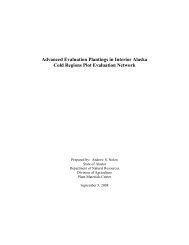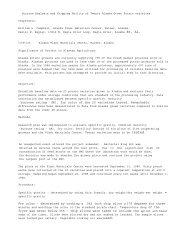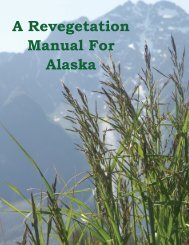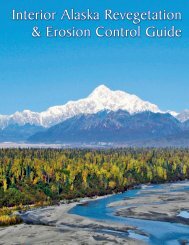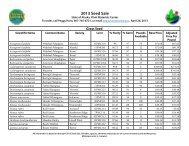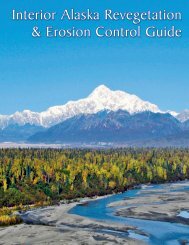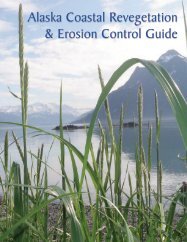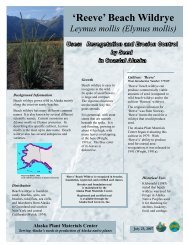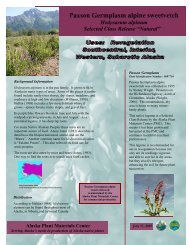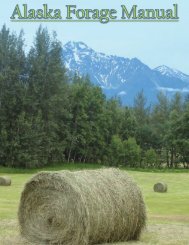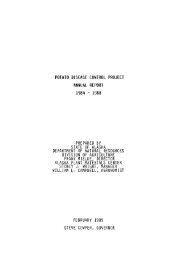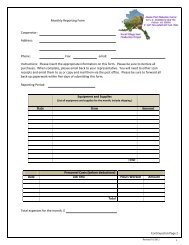Alaska Forage Manual - Alaska Plant Materials Center - State of ...
Alaska Forage Manual - Alaska Plant Materials Center - State of ...
Alaska Forage Manual - Alaska Plant Materials Center - State of ...
Create successful ePaper yourself
Turn your PDF publications into a flip-book with our unique Google optimized e-Paper software.
ALSIKE CLOVER<br />
Photo: User Aiwok (Wikimedia.org)<br />
Alsike Clover, Trifolium hybridum<br />
Alsike Clover<br />
Trifolium hybridum (L.)<br />
Description<br />
Trifolium hybridum, Alsike Clover is a short lived perennial<br />
and/or biennial legume that can reach 45 to 60 centimeters<br />
(18 to 24 inches) tall. It grows decumbent to erect vertically<br />
ridged culms. Leaves are palmately trifoliate with long<br />
petioles on the lower leaves and smaller or reduced petioles<br />
on the upper leaves. Individual leaflets are obovate (ovalish)<br />
or elliptic (narrow oval) with narrow tipped stipules. Alsike<br />
produces numerous flowers that are pink, red, and/or white<br />
and borne in leaf axils at the end <strong>of</strong> stems.<br />
Alsike is similar to several other introduced Trifolium<br />
species that occur throughout <strong>Alaska</strong>, such as Golden Clover<br />
(Trifolium aureum), Lupine Clover (T. lupinaster), Red Clover<br />
(T. pratense), White Clover (T. repens), and Field Clover (T.<br />
campestre). This legume produces a small round shaped seed,<br />
and most varieties produce roughly 650,000 seeds per pound<br />
<strong>of</strong> seed. Seedling vigor is low to moderate, depending upon<br />
the selected variety.<br />
Uses<br />
Livestock: Alsike is used for hay and pasture grazing. It is<br />
highly palatable to all classes <strong>of</strong> livestock. Caution should be<br />
taken when feeding Alsike to horses, as it can be toxic under<br />
some conditions. Also be cautious when feeding Alsike in large<br />
quantities, due to its high bloat hazard.<br />
Wildlife: Alsike is highly palatable to a variety <strong>of</strong> large wildlife,<br />
such as deer, elk and bison. It is utilized as food and cover<br />
by small mammals, waterfowl and upland game birds. Canada<br />
geese, sandhill cranes, rough grouse and mallard ducks utilize<br />
Alsike Clover.<br />
<strong>Forage</strong> Value<br />
Alsike is capable <strong>of</strong> producing large amounts <strong>of</strong> protein<br />
and is excellent quality forage for most classes <strong>of</strong> livestock<br />
and wildlife. Although it is generally out-produced by other<br />
legumes, it is highly palatable and produces a high relative feed<br />
value (RFV). It provides adequate mineral and vitamin content<br />
and is commonly grown with other grass species, including<br />
Timothy (Phleum pratense). As with most legumes, caution<br />
should be taken when feeding alsike due to the possibility <strong>of</strong><br />
bloat.<br />
Distribution and Adaptation<br />
Alsike is adapted to a variety <strong>of</strong> climatic and soil conditions. It<br />
is found growing throughout the entire United <strong>State</strong>s and parts<br />
<strong>of</strong> Canada. Alsike can tolerate fine to medium textured soils<br />
with a pH ranging from 5.6 to 7.5. Although it can persist in<br />
wetter and more acidic soils better than other clover species,<br />
Alsike will not tolerate shady, droughty or saline environments.<br />
Culture<br />
Alsike should be planted ¼ to ½ inches deep in a firm seed bed,<br />
preferably in silty loams and/or finer textured soils. Seeding<br />
rates depend greatly upon soil type, moisture, and location.<br />
An average seeding rate when broadcast seeding Alsike is 6<br />
lbs/acre and 2-4 lbs/acre when drill seeding. Seed should be<br />
inoculated prior to planting with appropriate rhizobium to<br />
assist plant establishment. Seeding rates are determined using<br />
Pure Live Seed (PLS) calculations, as described in Appendix B.<br />
Appropriate fertilizer ratios depend upon soil type, chemistry,<br />
and location. Soil samples should be collected and analyzed<br />
before field seeding. High rates <strong>of</strong> nitrogen application can<br />
damage or destroy stands <strong>of</strong> Alsike, and caution should be<br />
taken when applying fertilizer. Pastures and hay fields should<br />
be irrigated when necessary and/or applicable.<br />
Management<br />
Alsike makes an excellent pasture or hay forage. This legume<br />
is adapted to acidic, poorly drained, and/or moderate to low<br />
nutrient soils. Alsike can be difficult to control for the first<br />
several years <strong>of</strong> production, due to its aggressive nature and<br />
tendency to compete with other plants. It is highly recommend<br />
that Alsike be seeded in combination with a grass species<br />
to keep it from dominating a forage stand. Typically, Alsike<br />
Clover is seeded with a grass species such as Timothy (Phleum<br />
pratense) to reduce the risk <strong>of</strong> bloating and toxic affects when<br />
feeding to horses. Seeding with a grass species will also help<br />
Alsike stand upright making for an easier harvest.<br />
73



